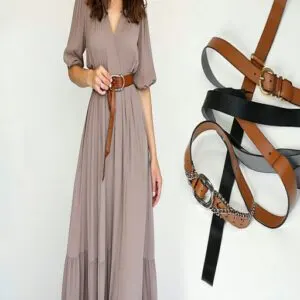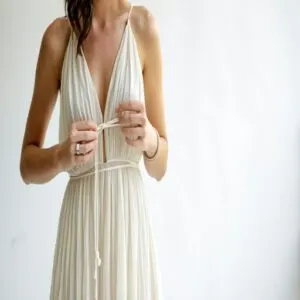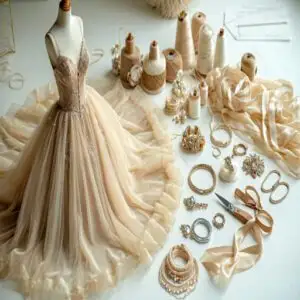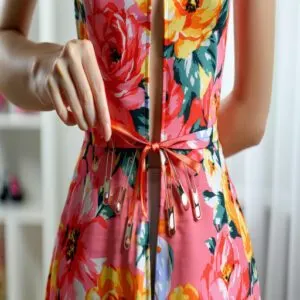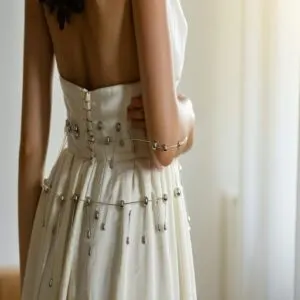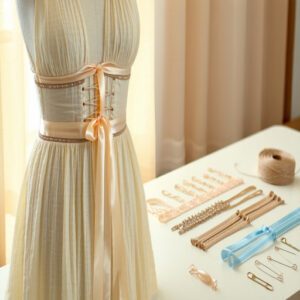This site is supported by our readers. We may earn a commission, at no cost to you, if you purchase through links.
 Want to know how to cinch a dress? It’s easier than you think!
Want to know how to cinch a dress? It’s easier than you think!
For a quick fix, grab a belt or fabric sash, wrap it around your natural waist, and tighten it for an instant hourglass look.
No belt? Use a brooch or safety pins to gather fabric at the sides—just keep them hidden for a polished finish.
Feeling creative? Tie a ribbon or scarf around your waist for a chic, boho vibe.
Prefer a snug, permanent fit? Try sewing elastic into the waistband. The trick is finding what works best with your dress’s fabric and style—practice makes perfect!
Table Of Contents
Key Takeaways
- Use quick fixes like belts, sashes, or safety pins to cinch your dress and achieve instant waist definition.
- Try creative options like ribbons, scarves, or the coin-and-hair-tie trick for easy non-sewing solutions.
- For a permanent fit, sew elastic into the waistband or add darts to create a tailored silhouette.
- Match your cinching method to the fabric type and dress style for the best results and a polished finish.
Cinching Dress Basics
You’ll be amazed at how easily you can transform that loose-fitting dress into a flattering silhouette, whether you’re handy with a needle and thread or prefer no-sew solutions.
From quick fixes with safety pins to more permanent alterations with elastic, you’ll find the perfect method to cinch your dress and show off your waistline in style.
Sewing in Elastic for Waist Cinching
If you’ve got a loose dress that needs taming, sewing in elastic creates a flattering waist cinch without any fuss.
You’ll need a sewing machine, elastic thread, and some basic measurements to get started.
To achieve a professional finish, consider using a sewing elastic technique that suits your garment type.
- Measure your waist and add 1 inch for comfort
- Create an elastic casing by folding fabric twice
- Thread your sewing machine with elastic thread
- Sew the casing, leaving room to thread the elastic band through
Non-Sewing Waist Cinching Techniques
While sewing works wonders, you’ve got plenty of no-sew tricks up your sleeve for the perfect waist fit.
Belt options range from classic leather to fabric sashes, while ribbon ties create a romantic touch.
Try a brooch to gather fabric at the sides, or wrap a scarf for boho flair.
Safety pins hidden on the inside can cinch your waist without any sewing – just gather, pin, and you’re ready to go.
Temporary Vs Permanent Solutions
Facing a dress that’s too loose, you’ve got quick fixes and forever solutions at your fingertips.
Temporary cinch techniques like belts, pins, and ribbons work great for last-minute adjustments.
For a permanent solution, consider sewing options like adding elastic or creating darts. To learn more about cinch a dress methods, think about your fabric choices and comfort level with DIY dress alterations before deciding on fastening methods that’ll give you that perfect cinched waist.
Think about your fabric choices and comfort level with DIY dress alterations before deciding on fastening methods that’ll give you that perfect cinched waist.
How to Cinch a Dress
You’ll be amazed at how quickly you can transform that loose-fitting dress into a flattering piece with these simple cinching techniques.
Whether you’re working with belts, safety pins, or ribbons, we’ll show you exactly how to get that perfect fit without spending a dime on alterations.
Using Belts and Sashes
Got an oversized dress? Belts and sashes are your secret weapons for instant waist definition.
Start by choosing your cinching tool – wide belts create drama, while slim ones offer subtle shaping.
To belt a dress perfectly, position it at your natural waist, typically the narrowest part.
For sashes, wrap twice around your waist and tie a secure knot.
Using dress belts for cinching can greatly enhance the overall appearance of your outfit.
Experiment with different belt styles and sash materials until you find your perfect fit.
Adding Brooches or Pins
While belts add structure, brooches and pins offer a more decorative way to cinch your dress.
Here’s how pin placement can transform your look:
- Gather fabric at the waist and secure with a statement brooch
- Create subtle pleats with small safety pins on the inside
- Use decorative pins in a V-pattern for a corset effect
- Place matching brooches on both sides for symmetry
- Try the viral anny arad safety pin hack for instant shaping
These fastening methods let you experiment with different adornment options while keeping your style uniquely yours.
Tying Ribbons or Scarves
Transform your dress’s silhouette with ribbons and scarves – they’re the secret weapons of waist cinching.
To cinch waist without belt drama, wrap your chosen fabric twice around your middle, slightly gather the dress fabric, then tie a neat bow at your back or side.
Mastering sewing knot techniques can also enhance your overall sewing skills, allowing for more creative and secure ways to cinch a dress.
Experiment with different scarf knots for fresh styling options, using materials like silk scarves for a luxe look or grosgrain ribbons for structure.
Utilizing Elastic Bands or Hair Ties
Got a hair tie handy? Here’s a quick cinching hack: Loop a thick elastic band or hair tie around a bangle, then gather your dress fabric through it.
You’ll want to position this DIY cinch at your natural waistline for the most flattering shape.
For wider dresses, use two or three hair ties spaced evenly – it’ll create a more balanced cinch waist effect.
Choosing Cinching Method
You’ll want to pick your cinching method based on your dress’s fabric and your comfort level, just like choosing the right tool for a home project.
Whether you’re working with delicate silk that needs a gentle touch or sturdy cotton that can handle safety pins, there’s a perfect cinching solution waiting for you.
Considering Fabric Type
Your fabric choice can make or break a cinched waist on a dress.
Light materials like cotton or rayon are perfect for sewing elastic, while heavier fabrics may need sturdier solutions.
For best results, consider fabric drape and stretch before committing to a cinching method.
Avoid slippery textiles if you’re using safety pins—they’ll slide everywhere.
Always test delicate fabrics first, so your cinch doesn’t mean fashion disasters.
Choose wisely; comfort matters!
Evaluating Dress Style
Now that you’ve figured out your fabric, let’s match your dress style to the perfect cinching method. The right technique depends on your dress’s unique features and how you want the cinched waist to look on your body silhouette.
- Check if the neckline plays nice with your chosen cinching method – a deep V might need different handling than a boat neck
- Consider how the dress length affects the waist proportion
- Think about whether style trends align with your cinching goals
- Look at how your fabric choice drapes when cinched – some fabrics bunch up while others flow
When you cinch dress tighter, remember that each style has different sweet spots. A maxi might need a different approach than a midi to style a loose dress that’s too big.
Assessing Personal Preference
While dress styles set the foundation, your body type and personal taste guide the perfect cinching method.
Think about your lifestyle needs – do you want quick fixes for occasional wear, or are you after lasting solutions.
Some prefer subtle adjustments, while others love dramatic cinched waist effects.
Match your fashion goals with comfortable techniques that make you feel confident about how you tighten dress waist.
Cinching Dress Techniques
You’ll be amazed at how a few simple tricks with safety pins and elastic can transform your loose dress into a perfect-fitting outfit.
Whether you’re going for a quick fix or a more permanent solution, these tried-and-tested techniques will help you create that flattering, cinched waist you’ve been dreaming of.
The Safety Pin Hack
Ready to transform your baggy dress?
This viral TikTok safety pin hack will be your new best friend. Start with three safety pins and a shoelace or ribbon.
Turn your dress inside out, pinch the fabric at your waist, and insert the first safety pin. Create your own waist shaping magic by gathering the fabric and securing two more pins evenly on each side of the first one, which is a simple yet effective safety pin hack.
Alternating Safety Pin Placement
Tired of the basic safety pin hack? Let’s upgrade your pin placement game for better cinching results.
Space your safety pins about 2-3 inches apart, alternating between higher and lower positions around your waist. This pin placement pattern creates a more natural gather in the fabric, preventing that bunched-up look.
For more advanced techniques, explore sewing with a safety pin.
Want a pro tip? Try using smaller pins near the sides for a smoother silhouette and to achieve a more professional finish with the safety pin technique.
Using Elastic for a Fitted Look
From loose to lovely, elastic transforms your dress into a perfect-fitting piece that hugs your curves just right.
When choosing the right material, consider using dress cinching for a professional finish.
- Pick the right elastic type – flat or round elastic works best for light fabrics
- Thread elastic through a casing at your natural waist level
- Secure both ends with a zigzag stitch for a lasting cinched waistline
Here’s how to cinch a dress using elastic for that coveted waistline:
Employing Shapewear for Support
While elastic gives you quick results, shapewear takes your dress game to the next level.
Support garments work like magic for waist training and body contouring – they smooth everything out under that cinched waist on a dress.
Pick the right shapewear and you’ll nail that hourglass look every time.
| Shapewear Type | Best For | Slimming Level |
|---|---|---|
| High-Waist Brief | Daily Wear | Moderate |
| Body Suit | Full Coverage | Maximum |
| Waist Trainer | Special Events | Intense |
| Slip Dress | Light Control | Minimal |
| Compression Tank | Upper Body | Medium |
Refining Cinching Skills
You’ll master the art of cinching when you practice with different materials and pay attention to how each fabric behaves differently.
Whether you’re working with ribbons, elastic bands, or safety pins, you’ll find that each dress needs its own special touch to achieve that perfect waist-hugging fit.
Experimenting With Different Materials
After trying the basic cinching methods, it’s time to level up your game.
Start with different elastic types – from braided to knitted – to see which gives you the perfect cinch a dress needs.
Switch between satin ribbons and grosgrain for varying textures around your dress waist.
Don’t shy away from testing thread options too – sometimes a sturdy cotton thread works better than elastic for those vintage-style cinched waist looks.
Practicing for a Smooth Finish
You’ve picked your materials – now let’s perfect that cinch.
Start with fabric preparation: smooth out wrinkles and lay your dress flat.
To achieve a professional finish, consider using fabric finishing techniques.
Practice your chosen cinching technique on old clothes first – this helps nail down garment fitting without stress.
When adjusting dress fit, take it slow and check the texture control in natural light.
Want to cinch a dress tighter? Keep tweaking until you’ve got that perfect waistband pull.
Adapting to Changing Fashion Trends
Fashion always keeps us guessing, doesn’t it?
Right now, style adaptation leans on trend forecasting–layering dresses with pants or adding sheer overlays are grabbing attention.
To cinch dresses tighter and stay stylish, try bold runway influences like wide belts or seasonal flair like soft, crochet details.
Keeping up lets you adjust dress fit effortlessly.
Troubleshooting Common Cinching Issues
Struggling with cinching mishaps? Here’s how to fix common issues:
- Fabric Issues: For tricky fabrics, secure safety pins tightly or pre-knot thread.
- Cinch Failures: Reinforce elastic loops to handle tension.
- Waist Gaps: Tuck fabric neatly under belts or ribbons.
- Elastic Breakage: Double-thread elastic for strength.
- Fit Problems: Adjust with brooches or DIY side ties.
Frequently Asked Questions (FAQs)
How to make a dress fit tighter without sewing?
Think of your dress like clay you can mold.
Use a belt for quick shaping, tie a scarf around your waist, or gather the fabric with safety pins and a ribbon for a snug fit.
How can I tighten my dress myself?
Grab a belt, sash, or even a scarf to cinch your waist instantly.
Don’t have those? Try the safety pin and ribbon trick—tie it snugly inside the dress for a quick DIY fit fix!
How to make your waist look cinched?
Imagine sculpting your silhouette like an artist molds clay—belts, corsets, or elastic bands can define your waist effortlessly.
Layer a fitted top, use shirring techniques, or tie ribbons creatively for instant curves.
How do you fix a dress that is too big in the waist?
Pinch the fabric at the waistline, then sew darts or add elastic for a fitted fit.
If you’re avoiding sewing, try safety pins, a belt, or the ribbon hack to cinch it temporarily.
How do you cinch an oversized dress?
To achieve a snug fit, you can try various methods to adjust your dress.
Wrap a thick belt, use safety pins and ribbon hidden inside, or try a quick bangle-and-hair-tie trick.
For a more permanent solution, sew elastic inside the waistband.
Each method adjusts your dress effortlessly.
How do you cinch a dress at the waist?
Ever feel like a dress is wearing you instead of the other way around?
Add definition with a belt, sew elastic for a permanent fix, or use safety pins and ribbon for a quick, stylish hack.
How to cinch a dress without a piercing?
Grab a belt, sash, or scarf to define your waistline instantly.
Or try a bangle and hair tie trick—secure the fabric, adjust the fit, and voilà!
Stylish cinching, no needles or piercings needed.
How do you cinch a dress with a coin?
Did you know 60% of people find creative hacks for oversized clothes?
To cinch with a coin, tuck fabric around the coin from inside the dress, secure it with a hair tie, and adjust.
How to cinch in a dress with elastic?
Sewing elastic into a dress creates a snug, custom fit.
Measure your waist, sew a fabric casing around the dress, thread the elastic through, and secure.
It’s perfect for lightweight fabrics like cotton or linen.
How do you cinch a dress with a sewing machine?
Think your dress needs shaping?
Grab your sewing machine, stitch a fabric casing around the waist, thread elastic through it, adjust snugly, and secure.
It’s quick, simple, and gives your dress a custom fit.
Conclusion
They say, "Where there’s a will, there’s a way," and cinching a dress is no different.
Whether you’re grabbing a belt, tying a ribbon, or pinning fabric for a quick fix, there’s always a method that fits your style.
Go bold with a statement sash or stay sleek with hidden safety pins.
Feeling crafty? Add elastic for a permanent touch! With these tips, you’ve got all you need to master how to cinch a dress flawlessly.
- https://yetanotherthread.com/how-to-cinch-a-dress-at-the-waist/
- https://www.wikihow.com/Take-in-a-Dress-at-the-Waist
- https://medium.com/@sewingbrain/how-to-cinch-a-dress-at-the-waist-ultimate-guide-956158bdbe22
- https://sewingmachinebuffs.com/how-to-cinch-a-dress-garment-without-sewing/
- https://www.pinterest.com/


